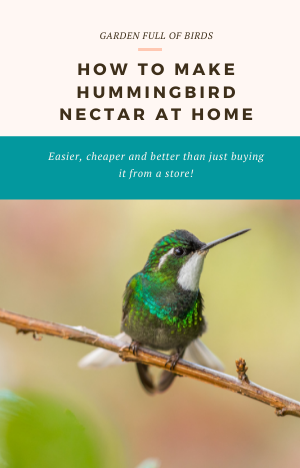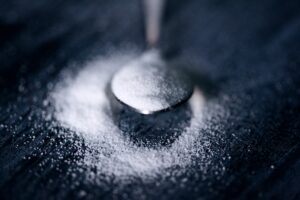
Hummingbirds are one of the smallest birds in the planet, but they are also one of the higher energy bird species you’ll find! They can hover while flapping their wings over 80 times per second, allowing them to dart to and fro the flowers that give them sustenance. They can also achieve speeds of 20 to 30 miles per hour, which for a bird that is smaller than your hand is absolutely amazing. That degree of energy means they have very specific and high calorie dietary requirements. They basically feed on flower nectar, visiting over 1000 flowers a day and drinking half their body weight in nectar every day (with the occasional bug for protein and flavour).
This is why it’s so important to learn how to make hummingbird nectar at home so you can help those little wonders of nature keep their energy levels up! Making homemade nectar is easy and cheap, as it’s mostly composed of sugar, and very rewarding when you see a crowd of hummers visiting your window hummingbird feeder at dawn and dusk. Sure, you can buy pre-mixed hummingbird food, but it’s so easy to make yourself that it’s a shame to go for commercial versions.

How Do You Make Hummingbird Nectar From Scratch?
There are many recipes for hummingbird juice, but the two main components are always water and sugar. This matches the composition of flower nectar, which is the main natural food for hummingbirds.
In this particular case, less is more and it’s not worth your time experimenting with adding additives, as some can be downright toxic to the hummers!
Your goal here is to imitate the composition of flower nectar, which is around 20% fructose, with trace amounts of amino acids and electrolytes. This is basically highly efficient fuel for the very demanding high metabolisms of the hummers. It’s a very simple recipe:
- Boil 1 cup of water. Tap water works great if it’s nice and clean, buy in areas with a high mineral content or with lots of chlorine you are better off using purified water to make hummingbird nectar at home.
- Mix in 1/4 of a cup of white, granulated sugar into the water. Stir, stir and stir again until the water dissolves.
- Wait for the solution to cool off, and keep it in the refrigerator for up to two weeks. Always best served cool!
To avoid the liquid fermenting, do not top up your hummingbird feeder with new nectar. Instead, empty the container and clean it throughly, and then refill it with a new batch of nectar at room temperature.
How To Make Hummingbird Nectar in Microwave?
If you aren’t keen on boiling water on a pot, you can always use the microwave to make hummingbird nectar instead. It’s very easy!
Just put the water into a clean, microwave-safe container and bring it to boiling temperature. Then stir in the sugar and that’s it, you just learned how to make hummingbird nectar in microwave.
It is important to boil the water though, not just heat it up. The reason for this is you want to kill any bacteria and slow down fermentation. Once the birds start putting their beaks into the feeder bacteria will be introduced, and you’ll still need to change the feeder contents regularly. But boiling the water slows down the start of this process.
What Type Of Sugar To Use?
White sugar is the way to go, whether it’s cane or beet. Organic sugar is usually not 100% white refined sugar (which is great for humans) and contains molases. Molasses have iron, and iron is toxic for hummingbirds. Brown sugar, unrefined sugar, raw cane sugar, they all may contain iron or other minerals that can cause real harm to the birds.
So for once in a cooking recipe, white, 100% refined no additives sugar is best.
How about making hummingbird nectar with agave? That’s another hard no. Agave contains no sucrose, and flower nectar is made of sucrose. What about how to make hummingbird nectar at home using honey? White sugar, like nectar, is made of sucrose. Honey, on the other hand, is made of fructose and glucose, which the hummingbirds can’t digest the same way. They are all sugars, but they are very different types of sugar and in this case, white sugar is the way to go. Fructose also ferments much quicker, which basically means the nectar will spoil sooner.
And do not use artificial sweeteners, the hummers feed on sugary water because they need all the calories they can get.

Do I Need To Add Red Dye To Homemade Hummingbird Nectar?
Many people believe that red dye makes hummer food more appealing to the birds, but that’s not strictly true. The color red attracts them, but they will enjoy pure sugary water without chemical dyes as much as chemically color enhanced juice.
Most commercial feed manufacturers will add dye and claim it helps hummers find the feeders. This is not true, and they are just looking for ways to convince you to pay for more sugary, colored water.
If you are concerned hummingbirds aren’t coming to your feeder, buy a feeder that has red parts such as a red platform or red flowers. Or wrap a bit of red tape around the bottom or the hanger.
No products found.
Hummingbirds are clever, and they will identify easy sources of high quality, not dyed nectar, and come back regularly. They usually feed at dusk and dawn, so make sure that’s when you are looking for them.
Do not add red dye to homemade hummingbird nectar, and do not buy commercial hummer food with red dye or any other additives. It’s totally unnecessary.
Should I Always Use 4:1 Water To Sugar?
4:1 is the most commonly agreed recipe to make hummingbird nectar at home, but there are exceptions.
In fact, when hummingbirds are preparing to migrate or during winter, they have higher caloric requirements. If you have a heated hummingbird feeder or the birds in your area are preparing for their long trip down south in Autumn, a slightly more sugary mix will be very appreciated.
Go for 3:1 water to sugar. It’s perfectly safe for the hummers, just more caloric. In hot weather it will also spoil quicker so stick to 4:1 blend during the summer.
However, when learning how to make hummingbird nectar at home it’s important to keep in mind that 4:1 is the minimum concentration of sugar in water for hummingbird nectar. Never go lower than 4:1 though, because that sugar water for hummingbirds would be too weak to sustain them. It won’t hurt them right away, but it will make them less likely to come to your feeder, as they prefer higher concentrations.
In short, keep it to 4:1 in summer and switch to 3:1 in winter or colder weather, or the weeks before the migration south begins and your hummingbird feeder will be a popular hotspot.
Do Hummingbirds Prefer Homemade Nectar?
Hummingbirds don’t know if the liquid in their feeder is homemade or not, but they do appreciate the following:
- Just sugar and water, thanks! There are no weird chemicals on your homemade hummingbird nectar, unlike some commercial options
- More or less sugar concentration: The concentration can be adjusted to the birds needs and season
- Fresh nectar: Hummer nectar made by you is always fresh, unlike commercial options that can go stale after a while
Learning how to make hummingbird nectar at home is cheap as chips, and it’s also really really easy. Give it a try and enjoy the buzz of these marvels of nature right by your window!
Leave a Reply